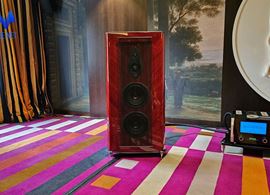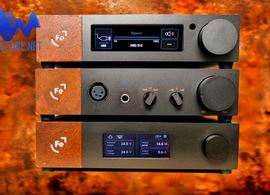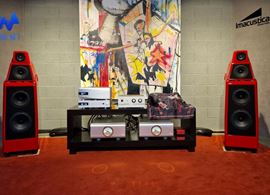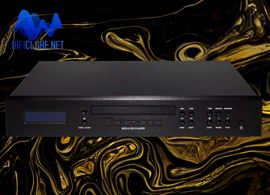Few stars shine as brightly in the constellation of high-end audio as Dan D'Agostino. Creator of legendary equipment, D'Agostino has long been synonymous with sonic excellence.
With the new Pendulum Integrated Amplifier, D'Agostino Master Audio Systems offers a solution that, although positioned as an "entry-level" product, represents a true manifesto of audiophile "democratization." It is a bold step toward making high-end sound accessible to a broader and more discerning audience.
At a relatively “modest” price of €22,000 (excluding optional modules), the Pendulum embodies the brand's DNA in a compact model with instant brand recognition.
Swiss Watchmaking
The Pendulum captures your attention immediately. Its brushed aluminum chassis, paired with striking copper accents, elevates the elegant yet understated design to a level of sophistication worthy of a genuine luxury product.
The central LCD screen isn’t just functional; it pays tribute to the analog VU meters on D’Agostino’s pricier gear, blending digital flair with old-school charm.
It displays real-time information such as source, volume, channel balance, polarity, and music metadata, while the selection is made with the rotary knobs on either side.
The Bluetooth remote control includes an antenna and is coated in Delrin featuring an LCD screen that mirrors the amplifier's front panel. Precision, intention, and luxury are natural extensions of the D'Agostino philosophy.
Measuring W43.2/H11.8/D35.6 cm and weighing 15.9 kg, the Pendulum exemplifies the ideal symbiosis of innovative industrial design and cutting-edge engineering.
Dan's DNA
At its core, the Pendulum is a discreet technological masterpiece. It borrows the JFET input circuit from the C2 preamp, elevating it to the same league as D’Agostino’s Momentum and Relentless flagships.
It delivers a pure, transparent, and precise sound that is rich in sonic nuances. This sound maintains a rare smoothness and effortless grace akin to the best tube amplifiers, like the first one Dan ever built (see interview).
The signal topology is fully balanced, featuring direct coupling and a complementary circuit that eliminates any trace of distortion, without resorting to the negative feedback band-aid.
At the heart of this machine is a 750 VA toroidal transformer supported by a 25,000 μF capacitor bank, which provides enough power to tame even the most demanding speakers. With 120W per channel into 8 ohms, doubling to 240W into 4 ohms, the Pendulum combines authority with delicacy: bass hits with punch, and microdynamics breathe naturally.
Versatility and Modernity
What truly sets the Pendulum apart is its chameleon-like versatility. Analog purists will be seduced by the four available inputs—a single-ended RCA line (configurable with the Phono module installed) and three balanced XLRs, including a theater pass-through mode for integration into AV systems.
The optional phono module (€1,380) offers 60 dB of gain for MC cartridges with various loading options via dip switches. For digital devotees, the additional module (€3,420) transforms the Pendulum into a streaming hub: PCM up to 32-bit/192kHz, DSD128, and compatibility with Tidal, Qobuz, Spotify, and Roon (pending certification).
Optical inputs, Ethernet, Wi-Fi, and, for the first time in a D'Agostino product, HDMI with eARC will open the door to the audiophile and audiovisual worlds. The iOS app control is intuitive and well-designed, although I feel neglected as an Android user. The Pendulum even offers a discreet headphone output hidden at the rear panel. We'll get to that shortly.
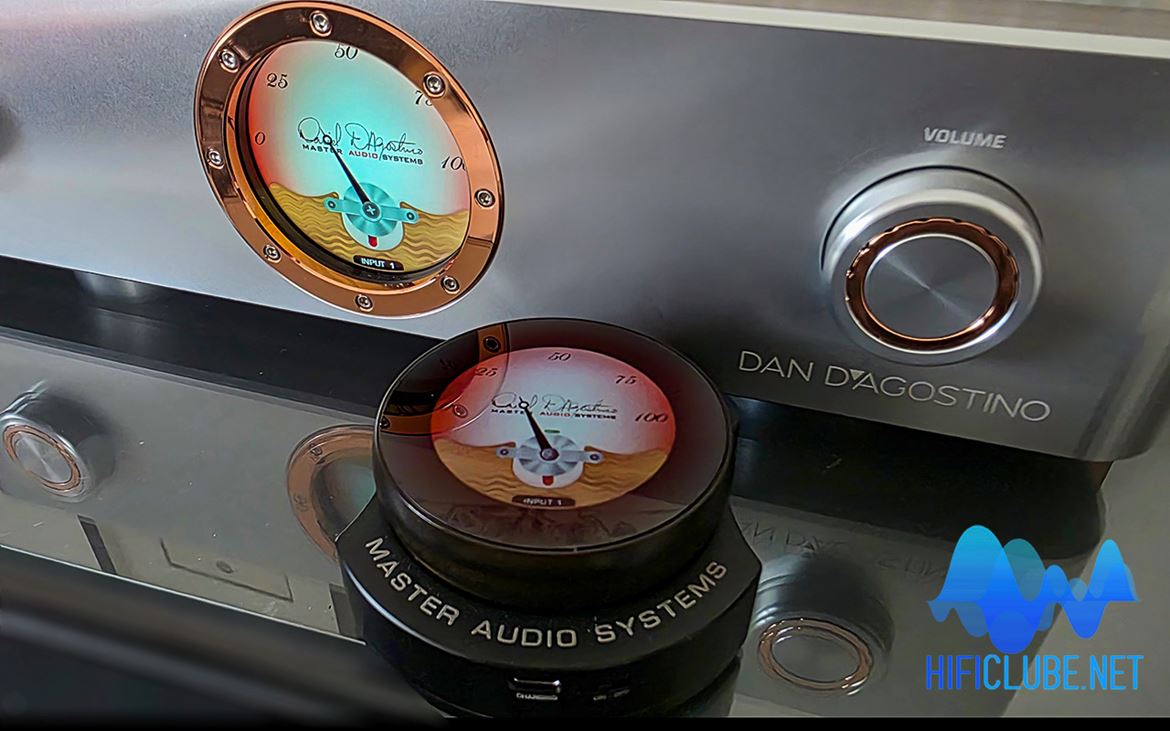
When you switch to reverse polarity mode, the display shifts from green to a reddish color.
Morse Code
It takes some time to realize that the Pendulum's ergonomics are well-designed, as they can be somewhat confusing due to the push/pull operation of the rotary knobs, particularly on the left side (standby, sources, channel balance, polarity, and music metadata). The right side only manages volume and mute.
The remote control replicates all functions, prioritizing ease of use and accessibility. Nonetheless, it might require some practice to understand that, like Morse code, a dot (a quick press) and a dash (a longer press) indicate different actions.
The Pendulum is never fully powered down. The display remains illuminated in standby mode (using 35 watts), proudly showcasing the brand logo.
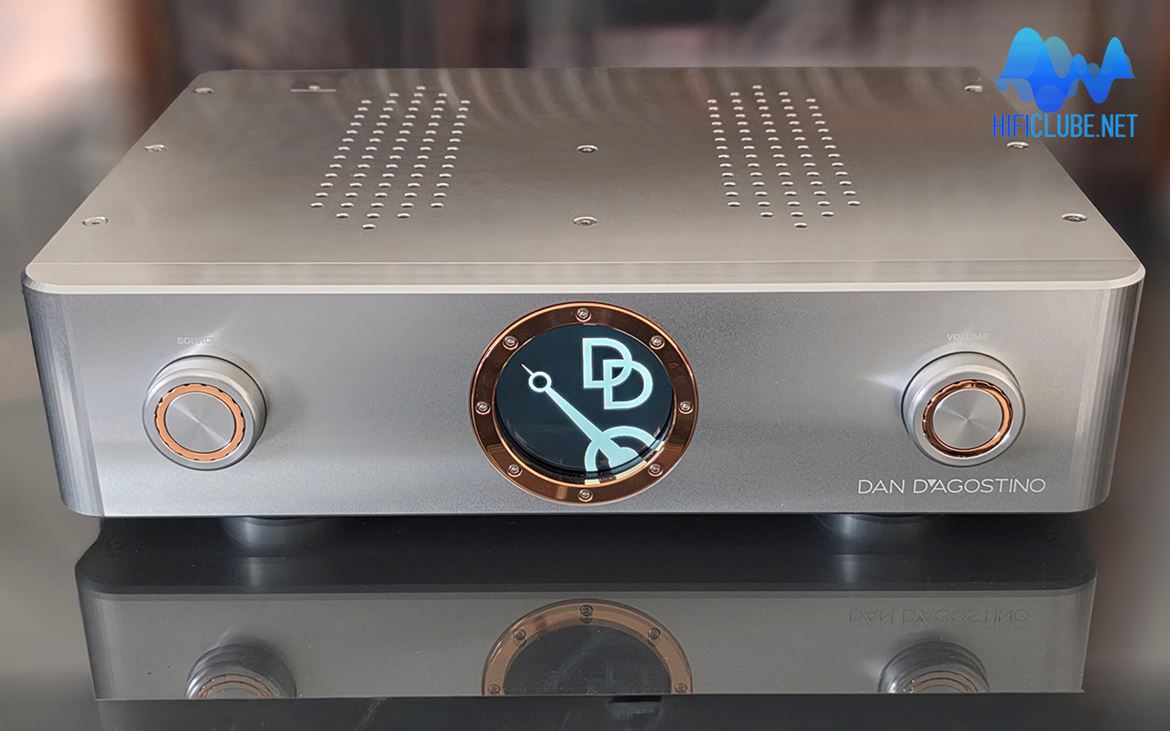
The display remains illuminated in standby mode (using 35 watts), proudly showcasing the brand logo.
The digital pointer operates differently from a VU meter; it merely shows the volume or channel balance. When you switch to reverse polarity mode, the display shifts from green to a reddish color.
Note: Some still claim it's not possible to hear a difference between “Inverted” and “Non-Inverted”. "Father, forgive them, for they do not know what they are doing."
After selecting any source or function by turning the knob, press the button to activate it, which also applies to the remote control. If you choose 'Network' (Ethernet RJ45 or WiFi), the metadata for the track playing on Tidal Connect, Qobuz, Spotify, or another media player like Audirvana briefly appears on the Pendulum and remote displays. This is a nice touch, literally. The only drawback is that sometimes there is some lag and interference in the Bluetooth transmission from the remote.
The iOS app offers an even better experience. However, as an Android user, I had to borrow my wife's iPad. Still, I had no issues connecting my Samsung S25 to the Pendulum via Tidal Connect or mConnect.
Roon, not ready (yet)
Yes, I know I haven't mentioned Roon yet. However, contrary to what was announced, the Pendulum does not yet have full certification. Roon identifies it immediately but informs you that, and I quote: 'Unfortunately, the manufacturer has not yet completed certification for the device. The certification process takes some time, so be patient. I used Audirvana with great success. Try it. It’s on par with Roon.
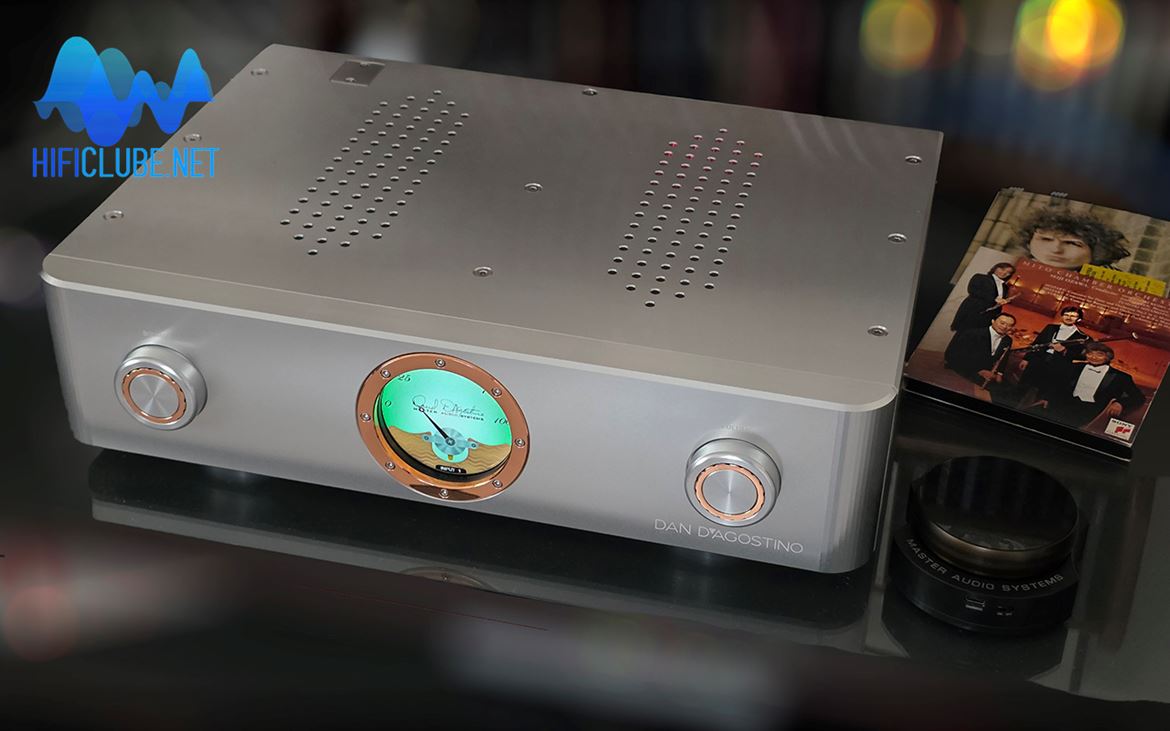
Digital Universe
The Pendulum's digital module, which arrived pre-installed, only has HDMI (eARC), optical, and Ethernet inputs, forgoing the more audiophile USB, AES-EBU, and coaxial (SPDIF) inputs. And when the file resolution is higher than supported by the Pendulum, Audirvana reproduces it anyway by downsampling, e.g.384kHz is downsampled to 192kHz, and DSD256/512 is downsampled to PCM176.4kHz. Not that you will hear a difference, I guarantee.
In the lengthy interview he kindly gave me, which you can watch on the video below, Dan positioned himself as an amplifier expert, leaving the digital realm of audio to manufacturers like dCS. Nevertheless, Dan's digital modules in his integrated amplifiers are not a compromise but rather a valuable solution to modern streaming trends.
Continuous Motion
During the interview, you'll discover that the names Dan chooses for his products carry significant personal meaning: Momentum symbolizes something he put in motion and no one can stop this time, while Relentless reflects his tenacity in the face of adversity. Progression also captures the concept of continuous motion in Dan D'Agostino's work.
Pendulum could very well be an analogy to the ups and downs in Dan's life; however, it also implies a pendulum movement, where each technological advance is followed by a return to the roots of musical emotion and the initial goosebump effect of Krell's early days. And that's what we feel when we listen to Pendulum: “goosebumps.” Similar to when we listen to Momentum or Relentless.
In the interview below, he ties this continuous motion to his constant quest for balance between price/quality, analogue/digital, tradition/modernity, and measurements/musicality.
Dan D'Agostino - A 'Momentum in Life' - an interview by JVH
Dan found the mythical philosopher's stone, and with every amplifier he builds, he turns aluminum and copper into sonic gold.
From Progression to Pendulum
In 2020, I conducted an auditory analysis of the Progression INT after testing the Progression Monoblocks and the Progression Preamp for Hi-Fi News, and wrote: “If you've always wanted a Momentum Integrated but feared the investment required, here's the next best thing for half the price...”.
Well, the new Pendulum comes remarkably close to the sound of the Momentum and the Relentless 800, making it a great deal.
Foucault's Pendulum
The Pendulum can power any speaker, no matter how difficult, so someone must have smiled when I connected it to a pair of small Sonus faber Concertino 4G monitors.
The Pendulum had the digital module installed, so I used Tidal's music library and my high-resolution files via Audirvana (more on this below). But I got the best sound with an Oppo player, connected via Transparent balanced cables, playing SACD. Vinyl lovers can purchase the Phono module as an option for €1,380.
I also listened to the headphone amplifier circuit with various models from different brands: Austrian Audio The Composer, Dali iO12, Meze Poet, and Hifiman HE1000. The Pendulum’s headphone output is solid, though it struggled a bit with my power-hungry Hifiman HE1000s (no surprise there, those cans are a beast!), hinting at Dan’s next frontier—a powerful dedicated amplifier, as he also revealed in the interview.
The new Pendulum comes remarkably close to the sound of the Momentum and the Relentless 800, making it a great deal.
Dan confessed that he no longer seeks technical perfection, such as distortion with many zeros after the decimal point. Just as it is possible to fool a lie detector, negative feedback can mislead measuring equipment. Therefore, an amplifier must have good measurements. However, these should be based on a well-designed circuit, not by using feedback as a band-aid.
A distortion of 0.01% is more than enough for human consumption. What counts most for him is musicality, not measurements. Dan’s ultimate goal is emotion, not zeros. Unfortunately, for mere mortals like us, there are too many zeros... in the price tag!
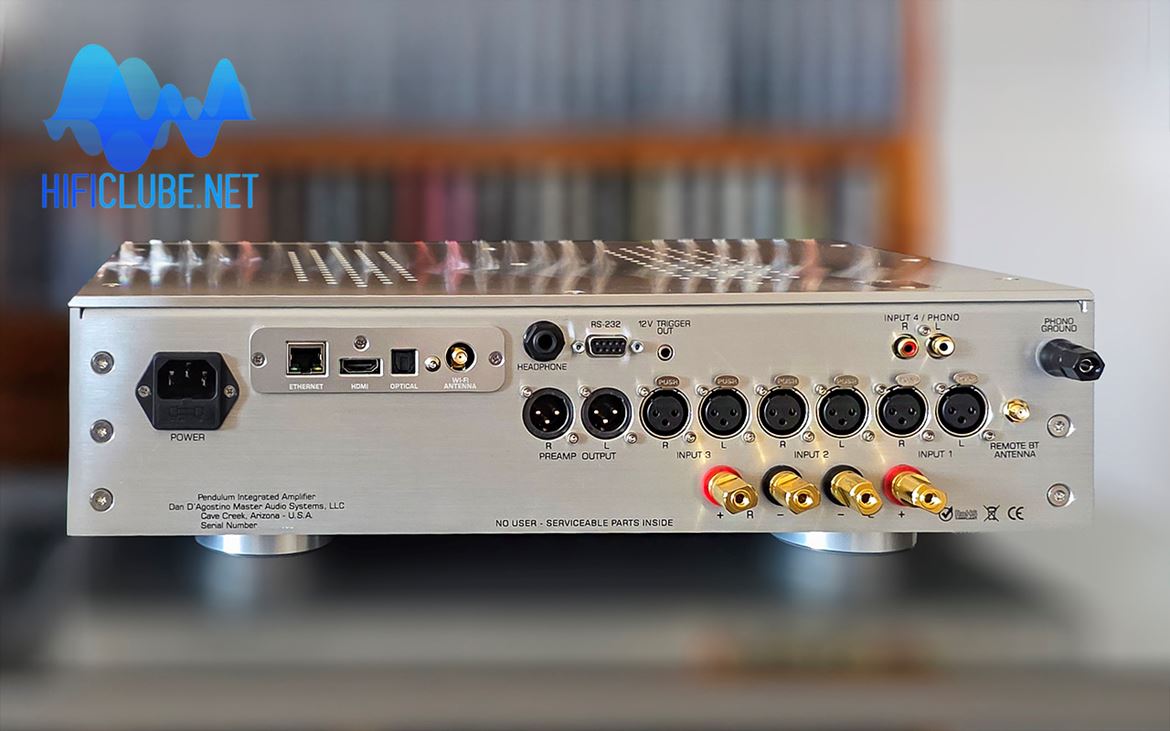
Optical inputs, Ethernet, Wi-Fi, and, for the first time in a D'Agostino product, HDMI with eARC will open the door to the audiophile and audiovisual worlds.
Pendulum Passes with Flying Colors
OK. But what sets the Pendulum apart from other great solid-state amplifiers that cost half or a third as much? Let me answer the question:
The total lack of grain and the way musicians are presented on stage; the vibrant colours and their saturation, the deep richness of the “blacks" or “silences”; the three-dimensional quality coupled with the sculptural high relief of all musical elements, and the genuine authenticity of the sound details; the reproduction of “decay” or natural fade away of each note; the dynamic response that is fast but never jarring; and the attack that, although very effective, remains gentle to the music, avoiding any harshness.
These traits are even more evident in the Relentless. However, while aspirations are a consistent part of life, reality frequently highlights what is (more) affordable instead, like the Pendulum.
Sound Impressions
Listening to Pendulum is like being transported to the Variety Playhouse to hear Sara Bareilles sing live “Let The Rain” (Tidal), accompanied only by guitar and the clapping of the audience, trying in vain to keep up with her rhythm. It ends with clean applause that sounds natural, not like white noise.
Sara's palpable presence and empathetic relationship with the audience are the best I’ve heard since Harry Belafonte’s legendary concert at Carnegie Hall, where everything seems to materialize with astonishing realism.
Seiji Ozawa's SACD (non-hybrid) with the Mito Chamber Orchestra performing Mozart's concertos for flute (Shigenori Kudo) and bassoon (Dag Jensen) is proof of SACD's superiority over CD. The balance of the orchestra and soloists, the DSD sound recording, and Seiji Ozawa's artistic sensitivity make listening to this album with the Pendulum an exciting musical experience.
Bill Evans' “Waltz for Debby" showcases the Pendulum's most ethereal qualities. Scott LaFaro's double bass's texture and weight resonate deeply, while Evans' piano sparkles with a shimmering clarity; each note appears suspended like dewdrops at dawn. Meanwhile, Paul Motian's brushes rhythmically sweep away the dry musical leaves falling on the snare drum.
In Chris Isaak's “Wicked Game,” the amplifier captures the essence of the song: the voice is rich, comforting, and laden with melancholy on a sound stage that feels both expansive and intimate. The Pendulum goes beyond just playing sound; it conveys the artist's vision with striking sincerity.
Reason and Emotion
The Dan D'Agostino Pendulum transcends its role as an integrated amplifier. It redefines aesthetics, technology, and emotion. Alas, it also demands personal commitment and financial investment. But its combination of raw electrical power and master artisan finesse, delivers a listening experience that is both exciting and captivating like no other in this category.
The Pendulum versatility meets the needs of the passionate vinyl collector, the digital music streamer lover, the devoted film enthusiast, and all music aficionados.
It is undoubtedly a bold investment, being roughly priced at €22,000 (+€3,420 for the digital module). Yet, in a realm where the sky is the limit (Relentless), the Pendulum offers a glimpse of paradise at an “affordable” price that may mark the onset of a new chapter in your audiophile life. A chapter signed by a living legend who relentlessly continues to expand the horizons of what can be achieved.
I just wish I could afford it. I will hate to see it go.
Watch in the video below Bill McKeegan showing how to install it.
Pendulum Integrated Amplifier Installation
We thank IMACUSTICA for the Pendulum loan which allowed Hificlube.net to publish what seems to be the world's first review.







